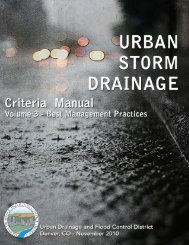Hydraulic Efficiency of Grate and Curb Inlets - Urban Drainage and ...
Hydraulic Efficiency of Grate and Curb Inlets - Urban Drainage and ...
Hydraulic Efficiency of Grate and Curb Inlets - Urban Drainage and ...
You also want an ePaper? Increase the reach of your titles
YUMPU automatically turns print PDFs into web optimized ePapers that Google loves.
Q<br />
⎛ L L Qw<br />
⎞<br />
= f ⎜ , ⎟<br />
Equation 2-21<br />
⎝ FT h Q ⎠<br />
w<br />
,<br />
where:<br />
Q = total flow;<br />
Q w = captured flow;<br />
L = inlet length;<br />
F = Froude number;<br />
T = top width <strong>of</strong> gutter flow; <strong>and</strong><br />
h = depth <strong>of</strong> flow in the gutter.<br />
For this inlet, the Froude number appears in the first parameter group, <strong>and</strong> ratios <strong>of</strong><br />
lengths <strong>and</strong> flows are used. The flow ratio used is typically called the inlet efficiency or capture<br />
efficiency.<br />
2.7 Summary<br />
Currently-accepted design procedures, which represent the state-<strong>of</strong>-the-art for inlet design<br />
from the UDFCD, were explained for each inlet used in this study. USDCM methods (which<br />
originated in HEC 22) are based upon theoretical parameters which must be determined from<br />
empirical relationships. The FHWA model, which provided data for development <strong>of</strong> HEC 22<br />
methods, was described. In addition, Manning’s equation <strong>and</strong> the Froude number were each<br />
defined as unique velocity-depth relationships. The process <strong>of</strong> dimensional analysis was<br />
explained as a commonly-used method for developing significant parameter groups that can be<br />
used in equation development. A survey <strong>of</strong> parameter groups identified as significant in<br />
determining inlet efficiency was conducted. Empirical equations have been used for determining<br />
the capacity <strong>of</strong> curb <strong>and</strong> grate inlets for composite gutter sections (in which the gutter cross slope<br />
does not equal the street cross slope). Most <strong>of</strong> the available research has been on gutters with<br />
uniform cross slopes. For gutters <strong>of</strong> uniform cross slope, Manning’s equation for a triangular<br />
cross section is frequently used for determining flow. Relationships exist for determining either<br />
curb or grate inlet capacity. Few relationships exist for combination inlets; they are typically<br />
treated as only a grate inlet. This is due to the observation that, when the grate is not depressed<br />
below the gutter flow line, little or no gain in performance results from the grate. A need exists<br />
for design equations, based on physically relevant <strong>and</strong> easy to determine parameters, which<br />
address use <strong>of</strong> combination inlets with the grate depressed below the gutter flow line.<br />
19
















